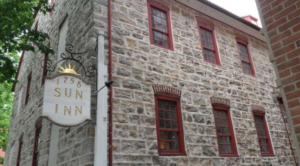The Lehigh Valley, nestled between Philadelphia and New York City, was witness to several Revolutionary War activities. We hosted several important Revolutionary visitors, housed the wounded in hospitals, and members of the community fought for freedom. Experience this fascinating chapter of American history. Visit the following sites to experience the story:
1758 Sun Inn
During the Revolutionary War, the Sun Inn’s significance grew as it became an important part of Bethlehem and the United States’ history. No other inn in the colonies may have welcomed so many distinguished guests: leading patriots, statesmen, five men who became U.S. President and military chieftains. The guest list includes George Washington, Martha Washington, Benjamin Franklin, John Adams, Samuel Adams, Ethan Allen, Alexander Hamilton, Henry Laurens, Richard Lee and Marquis de Lafayette.

Horner’s Cemetery Historical Society
Learn about the pastor of the Horner’s Cemetery church and cemetery, who was the first minister to die in the American Revolution. There have been multiple books written about him. Also, see the stone which commemorates General Robert Brown, a friend of George Washington. Our tours, with content, cover most of the veterans and their second generation families.

Northampton County Historical and Genealogical Society
The Northampton County Historical and Genealogical Society’s 1753 Bachmann Publick House was the gathering place for several notable Revolutionary era leaders. Records include John Adams of Massachusetts, William Ellery of Rhode Island, and William Whipple of New Hampshire, all signers of the Declaration of Independence visited the site. Pennsylvania signer George Taylor owned the tavern for a period of time. The Northampton County Historical and Genealogical Society’s 1807 Jacob Nicholas House is named after the original owner, Jacob Nicholas (circa 1770 – 1832). Jacob was an owner and captain of a Durham boat who likely worked his boat along the Delaware River between Easton and Philadelphia. Durham boats were an important tool in the economic and industrial history of our region. It is reported that there was up to several hundred Durham boats on the Delaware River moving goods. They were typically forty to sixty feet long, eight feet wide, and three and a half feet deep. This flat, long shape allowed them to haul heavy and large loads. The boats were elevated from local history to American history when they were used by General George Washington in his famous crossing of the Delaware River during the American Revolution.

Parsons-Taylor House
The Parsons-Taylor House was built in 1757 by Surveyor-General William Parsons and was later rented by George Taylor until his death in 1781. Taylor is noted as one of the signers of the Declaration of Independence, a member of the Continental Congress, and an ironmaster who aided in the American Revolutionary War effort. The house, listed on the National Register of Historic Places, is a 2-1/2 story, 2 bay stone dwelling in the Georgian style that has a three-part interior circular stairway.

Washington Crossing Historic Park
Visit this 500-acre park to see the point on the Delaware River from which a battered and dispirited American army launched a counterattack that reversed its long losing streak, preserving its will to fight, and maintaining the revolutionary spirit that would lead to independence for the United States.
Restored Colonial buildings in the park, such as the Thompson-Neely House and McConkey Ferry Inn, give many clues about living conditions during the Revolutionary era. Later, homes and shops reveal how 19th-century rural Pennsylvanians lived and worked. Among them are the home of a prosperous merchant, a village general store, and homes for skilled artisans. The park also contains Bowman’s Hill Tower, Revolutionary War soldiers’ graves, stone memorials, picnic pavilions and historic collections.
